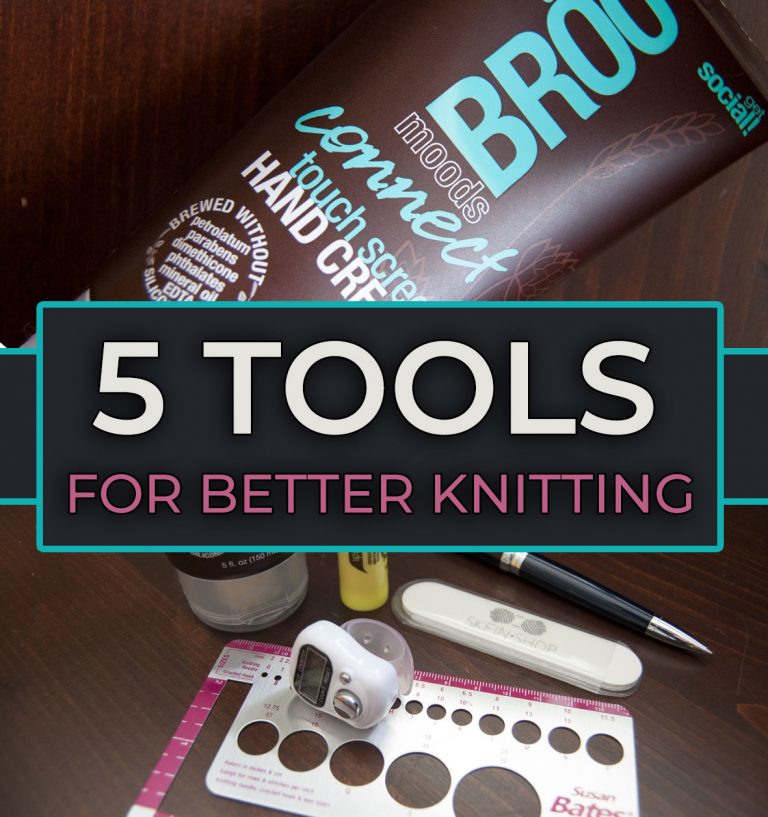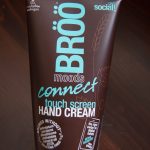 5 Knitting Tools You Need in Your Project Bag
5 Knitting Tools You Need in Your Project Bag5 Knitting Tools You Need in Your Project Bag
Everyone has their own list of necessary knitting tools to keep in a project bag. A large portion of these lists usually include stitch markers, scissors and yarn needles — some even list calculators and pens.
If we’re getting brutally honest, some of the lists out there are honestly just junk content telling you what every beginner already knows. My goal is to give you a more unique, albeit short, list of things you may have never thought to put in your knitting bag. But first, you don’t need a calcuator in their project bag. YOU HAVE A CELL PHONE and it’s probably right next to you. And that phone has a calculator app on it by default.
#1 Hands Free Knitting Row Counter Tool
My row counter is one of my favorite knitting tools right now.
I’m not talking about those annoying row counters with the little dials you have to twist. Using one of those requires setting your knitting down, twisting the dials and picking it back up again. Not efficient. You may have seen Clover’s Punch Knitting Counter, which is a step in the right direction, but it’s pretty large and also not convenient to use. Hiya Hiya takes it yet another step in the right direction with their pendant style Panda Row Counter. But again, you’re having to reach for something that may require you to have to set something down.
The best row counter tool for knitting has an adjustable strap to fit around your index finger, well within reach without letting go of your needles. Some row counters of this type use elastic, but I prefer the plastic bands that won’t stretch. Many people don’t like the plastic and find their fingers sweat, but I still prefer it.
You can probably find this same style of row counter from a variety of manufacturers, but this Susan Bates Row Counter is exactly what I recommend.
#2 A Mini Nail File to Stop Knitting Snags
I stumbled across this purely by accident. Never would I have thought a nail file would be one of the knitting tools I needed in my bag.
I ordered a skein of Louet Gems Sport from a great little yarn shop named Skein Shop. As a free gift in my order, they included a mini nail file with their logo on it. Honestly, all yarn shops should do this instead of handing out business cards because it is so much more practical. I stashed my mini nail file in my old-cigarillo-tin stitch marker case not sure how often I’d use it. Since then I have used it countless times to smooth out a nail that was snagging my yarn.
Maybe this isn’t a problem for those of you who get manicures. But I work with my hands in the yard, in the garage, etc AND I’m occasionally a nail biter. My nails can get a little rough around the edges and having a mini nail file in my project bag is a yarn-saver.
#3 Hand Cream to Perfect Knitting Gauge
Your favorite hand cream is perfectly capable of doubling as a knitting tool.
Depending on how you knit (or crochet), you’re probably used to wrapping the yarn between or around some fingers to keep the appropriate tension on your yarn. If your hands are too moist, the yarn doesn’t feed through your fingers smoothly and your tension is too tight. When your hands are too dry, the yarn feeds too easily and your tension is looser than usual. My knitting gauge really suffers from moisture irregularities.
There isn’t much you can do about moist hands other than to keep drying them. But hand cream makes a huge difference with dry hands, helping to keep your tension in a normal range rather than too loose. It can also really help if your hands are feeling rough from working with cotton or hemp yarns.
I have a bottle of Broo Connect Hand Cream in my bag right now, but you could use any hand cream that is supposed to absorb quickly and leave little residue behind. Most people aren’t a fan of the smell of Broo, but they use natural fragrances that many are not used to. I love Broo shampoos and lotions so this was my choice – shop around and find something you love!
#4 Knitting Gauge Measuring Tool
You already have a measuring tape or ruler, do you really need special knitting tools tool to check your gauge?
Well, if you’re like me and you have a fabric tape, you may have heard this is not the most reliable for measuring gauge. Not to mention with a single tape/ruler, you’re only measuring one dimension at a time – stitches or rows. If you pull your knit fabric one way or another, your row count and stitch count adjust a bit. Thus, the most accurate way to measure is to count stitches and rows at the same time.
If you have your swatch pinned to a blocking mat, your fabric probably isn’t shifting enough a special tool is necessary for measuring. But I still think it matters to be able to measure row and stitch gauge at the same time. Particularly if you are doing quick checks laying your swatch flat on the coffee table in the middle of Stranger Things.
That is why you want a special knitting gauge measuring tool. I bought a cheap, basic Susan Bates Knit-check gauge tool, but you can find some really cute alternatives like this Brass Sheep Knitting gauge.
#5 A Pen & Highlighters to Notate Patterns
This knitting tool is the “cop out” of my list. Just having four items didn’t sound as good as having five!
If you prefer to work with paper patterns, having a pen on hand to make notes as you go along is a great thing to do. I mostly recommend the highlighters because sometimes you may end up with a charted pattern with very little visual definition between the stitches.
Many pattern designers are amazing and will color code their stitch charts, but not everyone does. Having a few highlighters of different colors allows you to do your own color coding — something that I did when I was making Here We Gnome Again. I use regular size highlighters, but I’d recommend mini highlighters for maximum project bag space. If you get highlighters small enough, they might fit in the elastic hooks typically reserved for extra needles.
Tell Us About Your Favorite Knitting Tools
We gave you our list of favorite knitting tools, now send us yours! We’d love to hear about what you have in your project back. What can’t you live without?
Featured in this Post

Hand Cream
Add these 5 tools to your knitting bag: